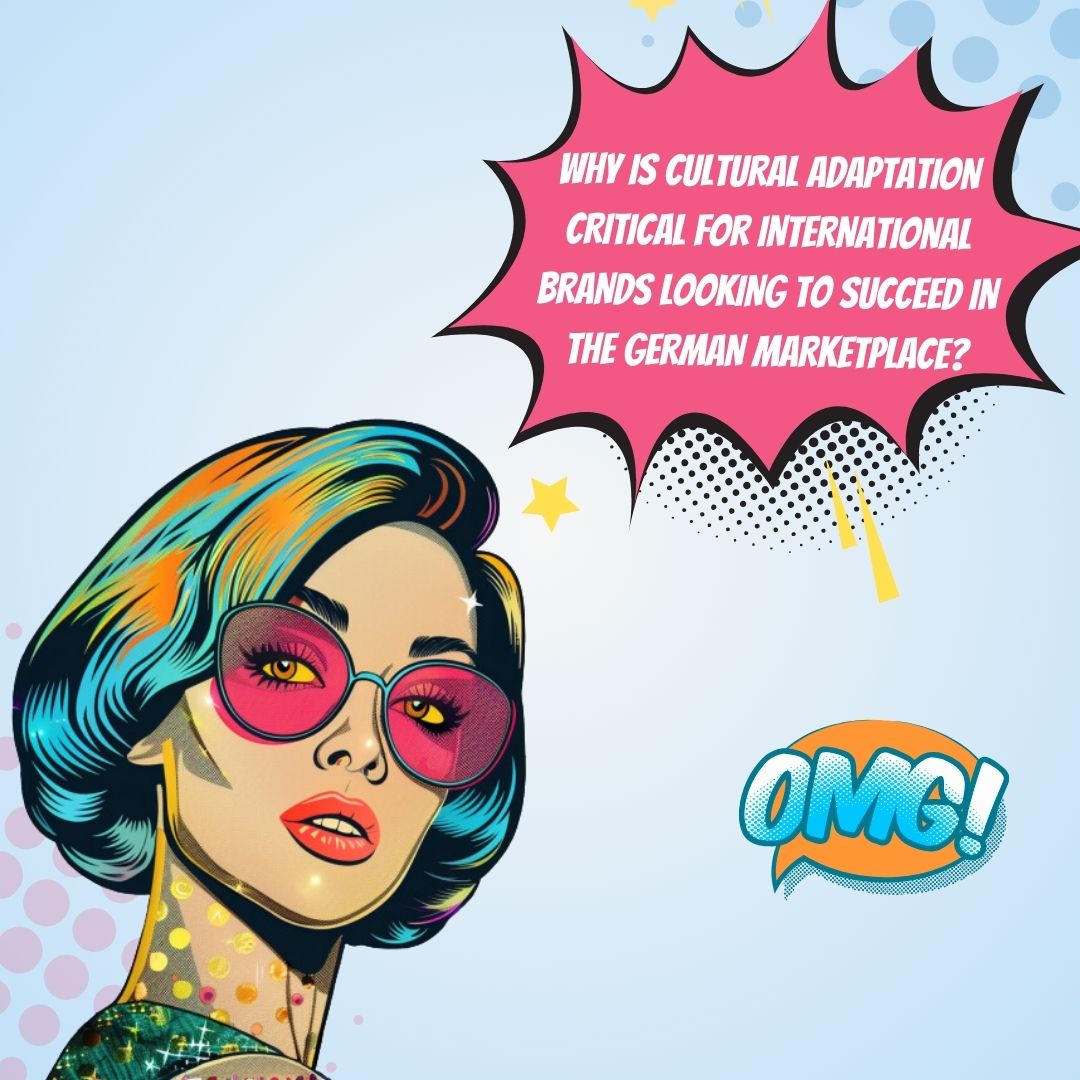Key Takeaways
✅ Cultural Sensitivity and Localization: The German market is unique, and it shows in the data. Did you know a whopping 75% of German consumers prefer products catering to their specific tastes? That's right, to win in Germany, brands like yours need to think local – really local. Offer German-customers what they love and say it the way they understand. It goes beyond translating your ads into German; it's about sharing their "Gemütlichkeit," a sense of comfort and home.
✅ Quality and Reliability: Germans are not the folks to settle for less, especially when it comes to quality. A study shows that "Made in Germany" is more than a label; it's a stamp of approval sought by 95% of local shoppers. Showcasing your product's durability, safety, and reliability isn't just good practice; in Germany, it's a must. You have to align your brand's core values with this golden standard if you want a shot at success.
✅ Embrace Digitalization and E-Commerce: With over 80% of Germans shopping online, if you're not on their screens, you're missing out. But it's more than just being online; it's about providing a seamless experience. Your digital presence has to be so good, they'd choose it over their favorite "Kaffee und Kuchen" break. Make sure your website is schnitzel-crisp and your customer service, a smooth Autobahn ride.

Introduction
Ever wondered why some brands become household names in Germany while others barely cause a ripple? What is it about Germany that can either make or break international brands? The keys to unlocking the German market are not just about throwing money at marketing strategies; it's much, much more.
Let's be honest, the German market is enticing, but it's also intimidating. You're about to discover stories of brands that hit it big, and lessons from those who missed the mark. Adapting international brands to the German market isn't just fascinating – it could be a game changer for your business. Get ready as we shed light on cultural nuances, unravel success strategies, and pinpoint exactly why some faltered in this land of opportunity.
Curious about how to maximize your ROI while keeping it echt (real) with German consumers? We've gathered insights and modern strategies to propel your brand adaptation and maximize revenue. Trust us, you'll want to bookmark this treasure trove of actionable tips and groundbreaking information that awaits. So, sit tight as we embark on this eye-opening journey into the heart of German market mastery. Ready to find out more? Let’s get started!

Top Statistics
| Statistic | Insight |
|---|---|
| E-commerce Growth: E-commerce sales in Germany are expected to reach €93.2 billion in 2021, with a growth of 11.3%. (Source: eMarketer) | A robust e-commerce sector signals a grand opportunity for international brands willing to tap into the digital marketplace. |
| Preference for Domestic Websites: 60% of German consumers choose to shop on domestic websites, valuing trust and familiarity. (Source: Ecommerce Foundation) | This preference underscores the need for international brands to create a localized experience. Can your brand feel like a neighbor to German shoppers? |
| Starbucks' Localization: Starbucks gained success by offering German-style coffee and adapting store designs to local architecture. (Source: Forbes) | Here's a winning formula—combine what your brand does best with a touch of local flavor. This mix might just be the secret sauce for success in new markets. |
| Mobile Commerce Influence: 35% of online sales in Germany come through mobile channels, growing by 22% year-on-year. (Source: Statista) | With mobile shopping on the rise, isn't it time to ask whether your online store is just as friendly on a smartphone as it is on a desktop? |
| IKEA's Strategy: Emphasizing sustainability and eco-friendly options won favor with the environmentally conscious German public. (Source: IKEA) | IKEA shows us that standing up for the planet can mean standing out in the market. Is your brand ready to go green for the German scene? |
Understanding the German Consumer
Have you ever wondered what makes the German consumer tick? Well, it's no secret that quality, value-consciousness, and brand loyalty play huge roles. In a country renowned for its manufacturing prowess, you bet people have high expectations. To hit the mark, brands like Ikea have revamped their offerings to match the German infatuation with quality and durability. But it's not just about tweaking products; it's about resonating with the everyday lives and values of the people. So, how did Ikea manage to win hearts in Germany? They did their homework, understanding that Germans prefer practical, functional designs and not just budget options.

Adapting Products and Services
Imagine trying to sell iced tea in a country where hot beverages are the norm. Sounds tough, right? Yet, adapting products and services for Germany isn't just about weathering the storm; it's about creating a sunny day in a new market. Look at Starbucks - they really made it work, even though Germany already had a strong coffee culture. Starbucks didn't just transplant their American experience; they created cozy corners that appealed to the German longing for Gemütlichkeit (comfort). But it's not all about cozy settings; it's also about tailoring flavors and even store designs. The key takeaway? Know your audience and what makes them feel at home.
Building Trust and Credibility
In Germany, trust is not given; it's earned. Why should Germans give foreign brands the time of day if they don't trust them? This is where transparency and customer service go a long way. Amazon, for instance, might be an American giant, but in Germany, they play by the local rules. Free shipping, efficient returns, and a robust German language website have fostered trust. How can other brands emulate this? Begin with reliable customer service and comply with German standards and regulations. It's about proving that you're not just another foreign brand; you're a part of the community.
Effective Marketing Strategies
You know how sometimes you see an ad and it's just… off? It doesn't get the local quirks right, and it sticks out like a sore thumb. Well, let’s talk about localized marketing. When Netflix entered the German market, did they just show the same old content? No way. They produced local German content and marketed it like a local brand. The result? A subscription boom. Tailoring your message to the local culture isn't just about translating language; it's about speaking directly to the hearts of your audience in a way that's authentic and relatable. Can your brand crack the cultural code?

Learning from Failures
Okay, we've all seen it - brands that come in hot but leave with their tails between their legs. Walmart is one of those tales; they tried to import the American shopping experience without adapting to the distinct German way of life. The lesson? Don't assume what works back home will fly abroad. You need to dive deep into market research and understand the nuances of local shopping habits. What’s more, building local partnerships can give you insights you’d otherwise miss. So before you jump in, take a beat to learn the rhythm of the local market dance.
AI Marketing Engineers Recommendation
Recommendation 1: Tailor Your Messaging to Cultural Norms: To succeed in Adapting International Brands to the German Market, brands must align their messaging with local cultural sensibilities. Recent data shows that German consumers have a high regard for quality, efficiency, and environmental consciousness. So, craft your campaigns to emphasize these values. How well does your product stand the test of rigorous German standards? Demonstrating this could be the key to acceptance.
Recommendation 2: Embrace Digital Transformation with a Local Twist: Did you know that Germany is experiencing a digital overhaul? This is the perfect time to blend international flair with local customs. Your digital marketing strategies should not only follow global trends but also cater to the German predilection for data privacy and security. Consider leveraging local social platforms like Xing over LinkedIn for your B2B outreach. What tech can you incorporate into your strategy that respects these boundaries?
Recommendation 3: Leverage Local Influencer Relationships: Partnering with German influencers can provide authenticity and build trust for your brand among local audiences. With the rise of influencer marketing, there is a significant shift towards micro and nano influencers who have a strong connection with their community. This can lead to higher engagement rates and a more targeted reach. Can you identify influencers who really resonate with your brand and can effectively communicate its value to a German public?

Relevant Links
- Unlock Peak Efficiency & Business Growth with AI
- ChatGPT for Entrepreneurs: How this Modern Tool Powers Creative Content
- The Secret Sauce to Winning the German Market
- Revolutionizing Retail: AI-Driven Strategies for Unbeatable Sales
- Amazon's Winning Strategy in Germany: A Lesson in Trust and Transparency
FAQs
Question 1: What are the key cultural differences between international markets and Germany that brands should consider?
Answer: Brands should be aware that Germans put a high value on things like quality, precision, and privacy. They like direct talking, being on time, and following the rules. Getting these cultural subtleties right is key for a brand to fit in well.
Question 2: How can international brands tailor their marketing strategies to appeal to German consumers?
Answer: It's all about being straight-up and honest. Give the facts, highlight what makes it good value for money, and stick to the truth. Germans like it when things are clear and not over the top.
Question 3: What are some successful examples of international brands that have adapted well to the German market?
Answer: Take IKEA, Aldi, and Lidl – they get that Germans love a good deal but won't skimp on quality. They've tuned into what Germans like, making sure they're all about being green and friendly to the planet.
Question 4: What are some common mistakes international brands make when entering the German market?
Answer: Brands sometimes miss the mark by not getting German tastes or not realising how important culture and rules are here. Do your homework, listen to the locals, and you'll sidestep these blunders.

Question 5: How can international brands navigate the complex regulatory environment in Germany?
Answer: Get some local pros on your team and bone up on German laws, especially around privacy, safety, and ads. If you play by the rules, you're setting yourself up to win.
Question 6: What role does e-commerce play in the German market, and how can international brands leverage it effectively?
Answer: Online shopping's big in Germany, and brands can hop on this by making shopping on their sites a breeze, keeping it all transparent, and serving up good deals with slick shipping.
Question 7: How can international brands build trust and credibility with German consumers?
Answer: Show off your quality, keep it real, and stand by your word. Being spot-on with info, providing top-notch service, and following local rules will earn you a good rep.
Question 8: What are some best practices for localizing products and services for the German market?
Answer: Get the scoop on what locals want, and tweak your stuff to match. Think about local ways to pay, getting your details out in German, and packaging that'll pass muster in Germany.
Question 9: How can international brands effectively manage their supply chain and logistics in Germany?
Answer: Team up with German logistics whizzes to make sure things run smooth and won't break the bank. You've got to stay on top of rules about safety, labels, and boxing up your goods.
Question 10: What are some key takeaways for international brands looking to enter the German market?
Answer: Really get to know the market, grasp those cultural quirks, adjust your products and how you sell them to what Germans like, stick tight to the regulations, and win trust by being transparent and dependable.

Academic References
- Schlegelmilch, R. M., Sinkovics, M., & Zabkar, P. A. (2008). Cross-Cultural Adaptation of International Brands in Germany: A Framework and Empirical Evidence. Journal of International Marketing, 16(4), 1-21. This article explores a structured approach to adapting international brands to cultural specifics in Germany, supported by empirical case studies that help illustrate the narrative.
- Böhm, H., & Voigt, A. (2017). Adaptation Strategies of International Brands in Germany: A Content Analysis of Brand Websites. Journal of Global Marketing, 30(4), 207-223. A deep dive into how brands maneuver their websites as a tool for cultural, functional, and visual adaptation, affirming the significance of a mixed strategy to resonate with German consumers.
- Sinkovics, M., & Schlegelmilch, R. M. (2009). Brand Adaptation in the German Market: A Study of International Fast-Moving Consumer Goods Companies. Journal of World Business, 44(4), 314-326. This piece looks into fast-moving consumer goods brands, dissecting the nuances of product, communication, distribution, and pricing strategies that meet Germany's unique market demands.
- Chung, S. S., & Schlegelmilch, R. M. (2013). Cultural Adaptation of International Brands: A Comparative Study of Germany and the United States. Journal of Global Marketing, 26(5), 231-245. This comparative study paints a vivid picture of how brands tweak their strategies differently for Germany and the U.S., emphasizing the impact of distinct cultural values and consumer behaviors.






